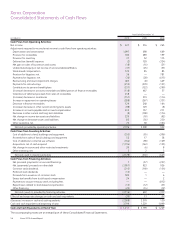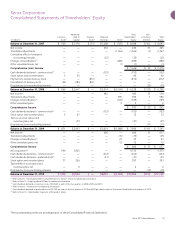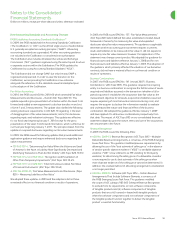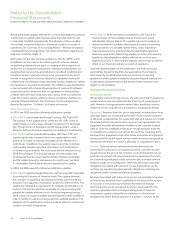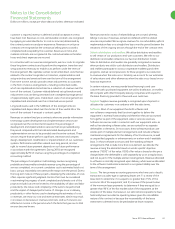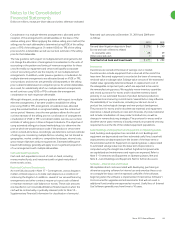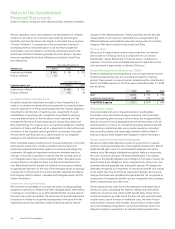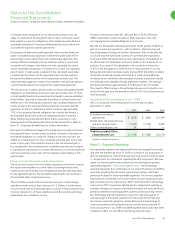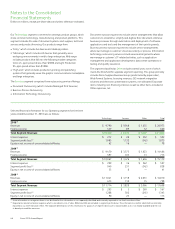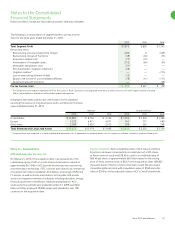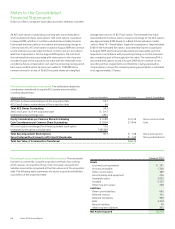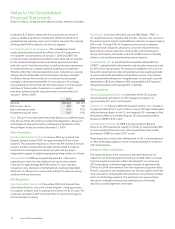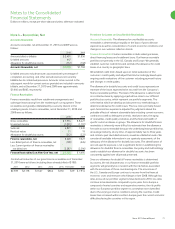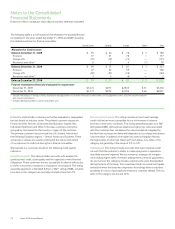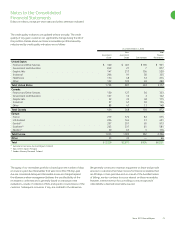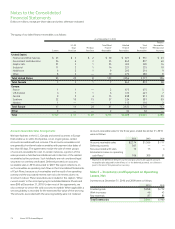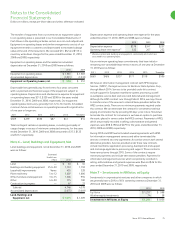Xerox 2010 Annual Report Download - page 67
Download and view the complete annual report
Please find page 67 of the 2010 Xerox annual report below. You can navigate through the pages in the report by either clicking on the pages listed below, or by using the keyword search tool below to find specific information within the annual report.
Notes to the Consolidated
Financial Statements
Dollars in millions, except per-share data and unless otherwise indicated.
65Xerox 2010 Annual Report
Foreign currency losses were $11, $26 and $34 in 2010, 2009 and
2008, respectively, and are included in Other expenses, net in the
accompanying Consolidated Statements of Income.
We sold our Venezuelan subsidiary during the fourth quarter of 2010 as
part of our restructuring actions – refer to Note 9 – Restructuring and
Asset Impairment Charges for further information. Prior to the sale, the
U.S. Dollar was the functional currency of our Venezuelan operations.
In January 2010, Venezuela announced a devaluation of the Bolivar to
an official rate of 4.30 Bolivars to the U.S. Dollar for the majority of our
products. As a result of this devaluation, we recorded a currency loss
of $21 in the first quarter of 2010 for the re-measurement of our net
Bolivar-denominated monetary assets. During 2010, the ability to obtain
U.S. Dollars remained severely restricted. As a result, during 2010 we
re-measured our net Bolivar-denominated monetary transactions based
on exchange rates available through alternative markets. The average
rate during 2010 was approximately 5.77 Bolivars to the U.S. Dollar.
The impact of this change in the exchange rate was not material to our
results for the year since we derived less than 0.5% of our total revenues
from Venezuela.
Accumulated Other Comprehensive Loss (“AOCL”)
AOCL is composed of the following for the three years ending
December 31, 2010:
2010 2009 2008
Cumulative translation
adjustments $ (835) $ (800) $ (1,395)
Benefit plans net actuarial losses
and prior service credits(1) (1,167) (1,190) (1,021)
Other unrealized gains, net 14 2 —
Total Accumulated Other
Comprehensive Loss $ (1,988) $ (1,988) $ (2,416)
(1) Includes our share of Fuji Xerox.
Note 2 – Segment Reporting
Our reportable segments are aligned with how we manage the business
and view the markets we serve. In 2010, as a result of our acquisition of
ACS, we realigned our internal financial reporting structure (refer to Note
3 – Acquisitions for information regarding the ACS acquisition). We now
report our financial performance based on the following two primary
reportable segments – Technology and Services. The Technology
segment represents the combination of our former Production and Office
segments excluding the document outsourcing business, which was
previously included in these reportable segments. The Services segment
represents the combination of our document outsourcing business and
ACS’s business process outsourcing (“BPO”) and information technology
outsourcing (“ITO”) businesses. We believe this realignment will help us
to better manage our business and view the markets we serve, which are
primarily centered around equipment systems and outsourcing services.
Our Technology segment operations involve the sale and support of
a broad range of document systems from entry level to the high-end.
Our Services segment operations involve delivery of a broad range of
outsourcing services including document, business processing and IT
outsourcing services. Our 2009 and 2008 segment disclosures have been
restated to reflect our new 2010 internal reporting structure.
on the plan asset component of our net periodic pension cost, we
apply our estimate of the long-term rate of return to the plan assets
that support our pension obligations, after deducting assets that are
specifically allocated to Transitional Retirement Accounts (which are
accounted for based on specific plan terms).
For purposes of determining the expected return on plan assets, we
utilize a calculated value approach in determining the value of the
pension plan assets, rather than a fair market value approach. The
primary difference between the two methods relates to systematic
recognition of changes in fair value over time (generally two years)
versus immediate recognition of changes in fair value. Our expected
rate of return on plan assets is applied to the calculated asset value
to determine the amount of the expected return on plan assets to
be used in the determination of the net periodic pension cost. The
calculated value approach reduces the volatility in net periodic pension
cost that would result from using the fair market value approach.
The discount rate is used to present value our future anticipated benefit
obligations. In estimating our discount rate, we consider rates of return
on high-quality fixed-income investments included in various published
bond indexes, adjusted to eliminate the effects of call provisions and
differences in the timing and amounts of cash outflows related to the
bonds, as well as the expected timing of pension and other benefit
payments. In the U.S. and the U.K., which comprise approximately
75% of our projected benefit obligation, we consider the Moody’s
Aa Corporate Bond Index and the International Index Company’s
iBoxx Sterling Corporate AA Cash Bond Index, respectively, in the
determination of the appropriate discount rate assumptions. Refer to
Note 15 – Employee Benefit Plans for further information.
Each year, the difference between the actual return on plan assets and
the expected return on plan assets, as well as increases or decreases in
the benefit obligation as a result of changes in the discount rate, are
added to or subtracted from any cumulative actuarial gain or loss that
arose in prior years. This resultant amount is the net actuarial gain or
loss recognized in Accumulated other comprehensive loss and is subject
to subsequent amortization to net periodic pension cost in future periods
over the remaining service lives of the employees participating in the
pension plan.
Foreign Currency Translation and Re-measurement
The functional currency for most foreign operations is the local currency.
Net assets are translated at current rates of exchange and income,
expense and cash flow items are translated at average exchange rates
for the applicable period. The translation adjustments are recorded in
Accumulated other comprehensive loss.
The U.S. Dollar is used as the functional currency for certain foreign
subsidiaries that conduct their business in U.S. Dollars. A combination
of current and historical exchange rates is used in re-measuring the local
currency transactions of these subsidiaries and the resulting exchange
adjustments are included in income.



